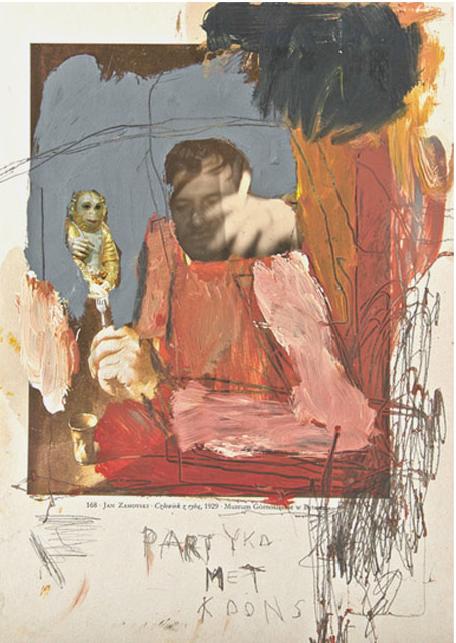
In one of Tomasz Partyka’s recent paintings, a party of mounted insurgents from Maksymilian Gierymski’s oil on canvas emerges from a landscape of cans and plastic paint containers. The miniature images of the horsemen have been cut out from a reproduction of the 19th-century work, a similar procedure as applied in other works from the recent series, filled with more or less recognisable fragments of historical Polish painting. Pasted onto one another, repainted, accompanied by comments, they come across as puzzling, but stylistically consistent, paintings-collages. These are pictures about how to interpret painting in defiance of art-historical canons, in sometimes absurd combinations of visual motifs with dedications for punk or hip-hop bands and their living or dead vocalists. The painting-remaking work involves browsing through coffee-table books and cutting out dozens of figures. From the 19th-century version of painted history, aristocratic and manorial, emerge herds of horses. Heads, croups, hooves, tails, manes, growing out of the shoulders, heads and hands of generals, officials, respectable matrons and odalisques. Too Many Horses is dedicated to a popular Beastie Boys song, Too Many Rappers. This jumble of quotations is not simply about borrowed aesthetics; through his paintings – glued up, torn, doodled over, with fragments of burnt rags – Partyka weaves his own narrative about Polish painting.


Forgive me, homeland, for all my sins, for everything I did wrong, for all those Kossaks, Siemiradzkis, Michałowskis and others… The words, scribbled on one of the paintings, could sound like a modernist’s complaint about the conservatism of the ‘Munich school’, only in some of the pictures Partyka repaints, in a similarly carefree manner, the classics of avant-garde art.

Szczuka Became Painter, 2012

Partyka Met Konns, 2012
Partyka began his practice of repainting, or rather pasting over, historical painting with 17th-century Dutch masters in the 2008 series Shadows of the Masters. In those small portraits, he combined the Baroque with the modern (Jan Weenix with Piet Mondrian), creating hybrids with geometric figures instead of heads. In the most recent works, reproduced portraits disappear under superscriptions, painted over or covered with photographs of other figures, becoming a part of, or invisible background for, new narratives. Mieczysław Szczuka ‘becomes a painter’ in a Self-Portrait with a face transformed into an absurd, whirling form. From Artur Nacht-Samborski’s colourist Portrait of a Young Woman in a Green Dress emerges a grotesquely convoluted figure with a shaven head, and in Jan Zamoyski’s realistic Man with a Fish ‘Partyka meets Koons’.
Tomasz Partyka (1978) graduated from Academy of Fine Arts in Poznań, M.A. Painting and Video. Lives and works in Warsaw. His solo exhibitions have been shown at venues such as Le Guern Gallary, Warsaw (2005; 2007), Les Complices, Zurich (2006); Laznia Center for Contemporary Art, Gdańsk; Galerie Zero, Berlin (2009); Entropia Gallery, Wroclaw (2010).
Curator: Bożena Czubak
